light TOYOTA YARIS CROSS 2022 User Guide
[x] Cancel search | Manufacturer: TOYOTA, Model Year: 2022, Model line: YARIS CROSS, Model: TOYOTA YARIS CROSS 2022Pages: 618, PDF Size: 130.77 MB
Page 25 of 618
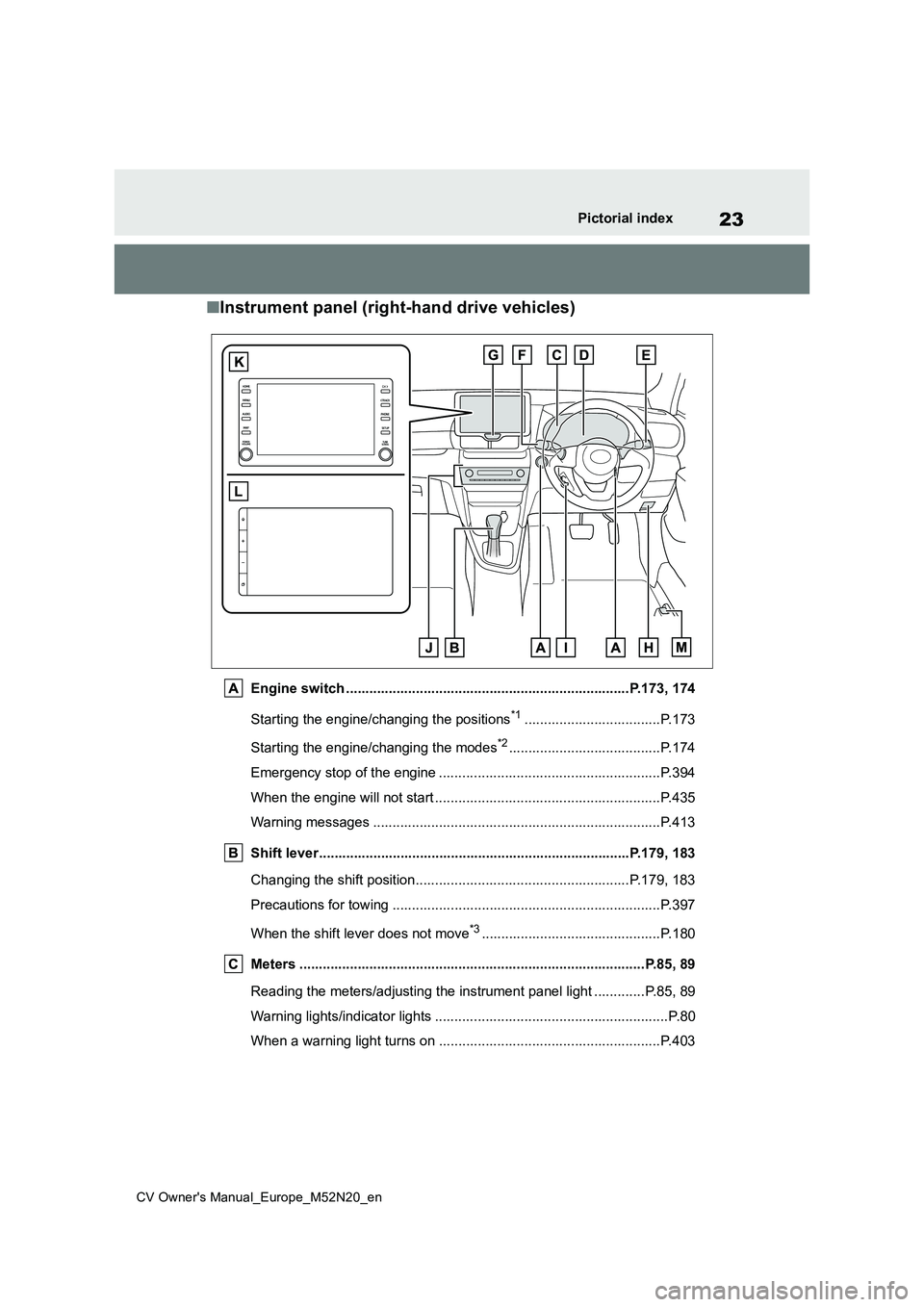
23
CV Owner's Manual_Europe_M52N20_en
Pictorial index
■Instrument panel (right-hand drive vehicles)
Engine switch .........................................................................P.173, 174
Starting the engine/changing the positions*1...................................P.173
Starting the engine/changing the modes*2.......................................P.174
Emergency stop of the engine ................................... ......................P.394
When the engine will not start ................................. .........................P.435
Warning messages ............................................... ...........................P.413
Shift lever.................................................... ............................P.179, 183
Changing the shift position.................................... ...................P.179, 183
Precautions for towing ......................................... ............................P.397
When the shift lever does not move*3..............................................P.180
Meters ......................................................... ................................P.85, 89
Reading the meters/adjusting the instrument panel light ........ .....P.85, 89
Warning lights/indicator lights ................................ ............................P.80
When a warning light turns on .................................. .......................P.403
Page 26 of 618
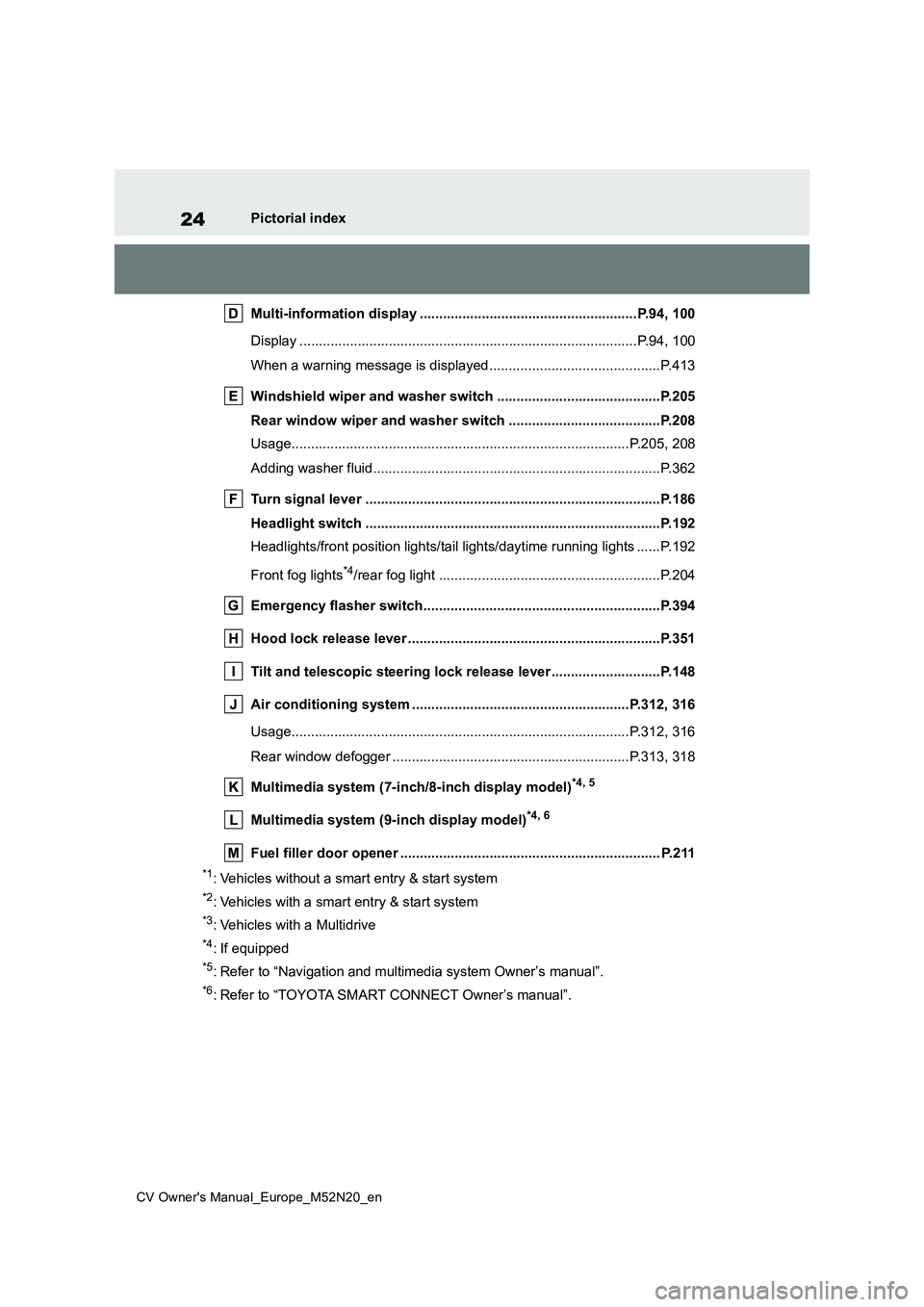
24
CV Owner's Manual_Europe_M52N20_en
Pictorial index
Multi-information display ...................................... ..................P.94, 100
Display ........................................................ ...............................P.94, 100
When a warning message is displayed............................ ................P.413
Windshield wiper and washer switch ............................. .............P.205
Rear window wiper and washer switch ............................ ...........P.208
Usage.......................................................... .............................P.205, 208
Adding washer fluid............................................ ..............................P.362
Turn signal lever .............................................. ..............................P.186
Headlight switch ............................................... .............................P.192
Headlights/front position lights/tail lights/daytime running li ghts ......P.192
Front fog lights*4/rear fog light ................................................ .........P.204
Emergency flasher switch....................................... ......................P.394
Hood lock release lever ........................................ .........................P.351
Tilt and telescopic steering lock release lever................ ............P.148
Air conditioning system ........................................ ................P.312, 316
Usage.......................................................... .............................P.312, 316
Rear window defogger ........................................... ..................P.313, 318
Multimedia system (7-inch/8-inch display model)*4, 5
Multimedia system (9-inch display model)*4, 6
Fuel filler door opener ........................................ ........................... P.211
*1: Vehicles without a smart entry & start system
*2: Vehicles with a smart entry & start system
*3: Vehicles with a Multidrive
*4: If equipped
*5: Refer to “Navigation and multimedia system Owner’s manual”.
*6: Refer to “TOYOTA SMART CONNECT Owner’s manual”.
Page 27 of 618
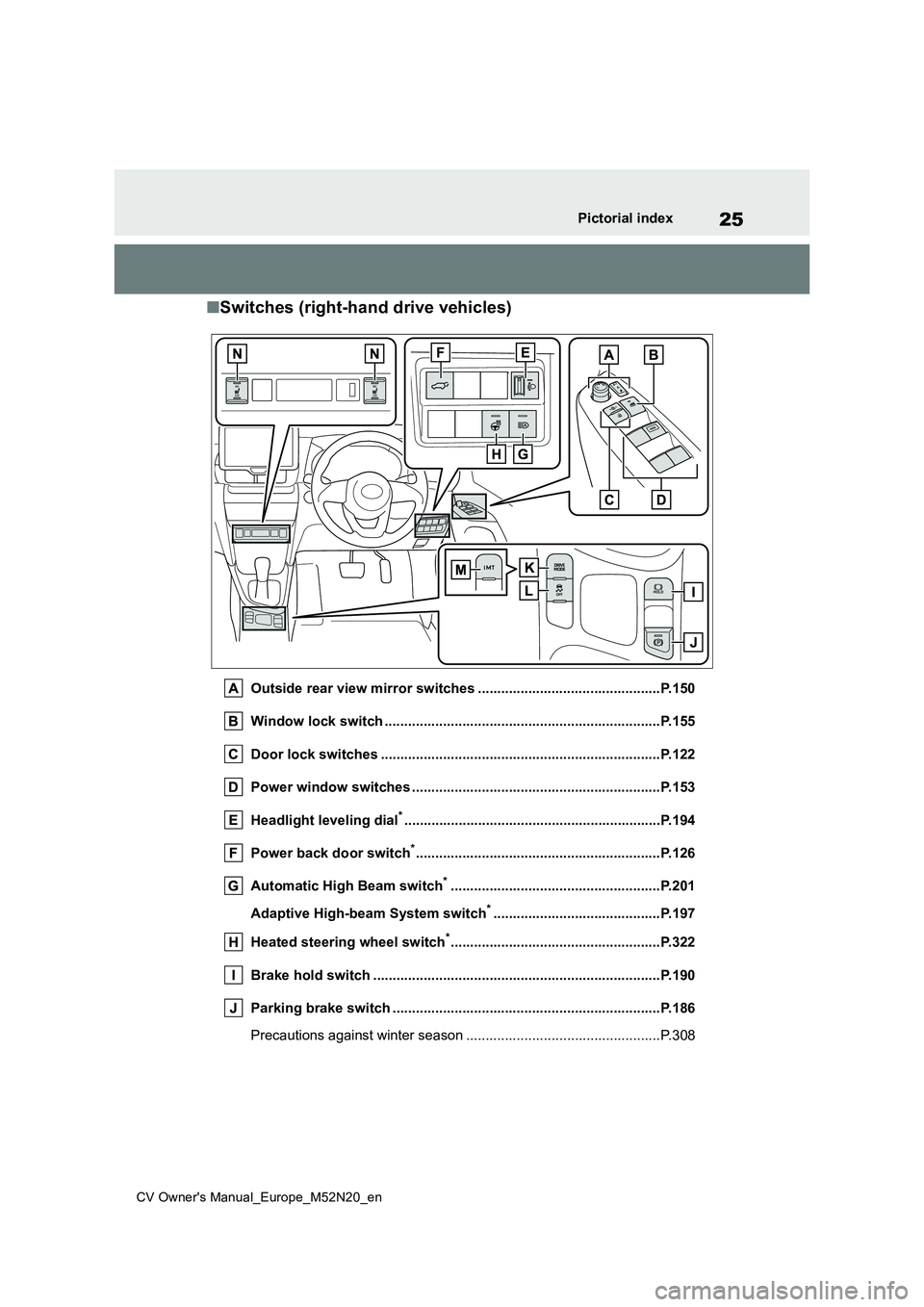
25
CV Owner's Manual_Europe_M52N20_en
Pictorial index
■Switches (right-hand drive vehicles)
Outside rear view mirror switches ...............................................P.150
Window lock switch ............................................. ..........................P.155
Door lock switches ............................................. ...........................P.122
Power window switches .......................................... ......................P.153
Headlight leveling dial*............................................................... ...P.194
Power back door switch*............................................................... P. 1 2 6
Automatic High Beam switch*......................................................P.201
Adaptive High-beam System switch*...........................................P.197
Heated steering wheel switch*......................................................P.322
Brake hold switch .............................................. ............................P.190
Parking brake switch ........................................... ..........................P.186
Precautions against winter season .............................. ....................P.308
Page 31 of 618
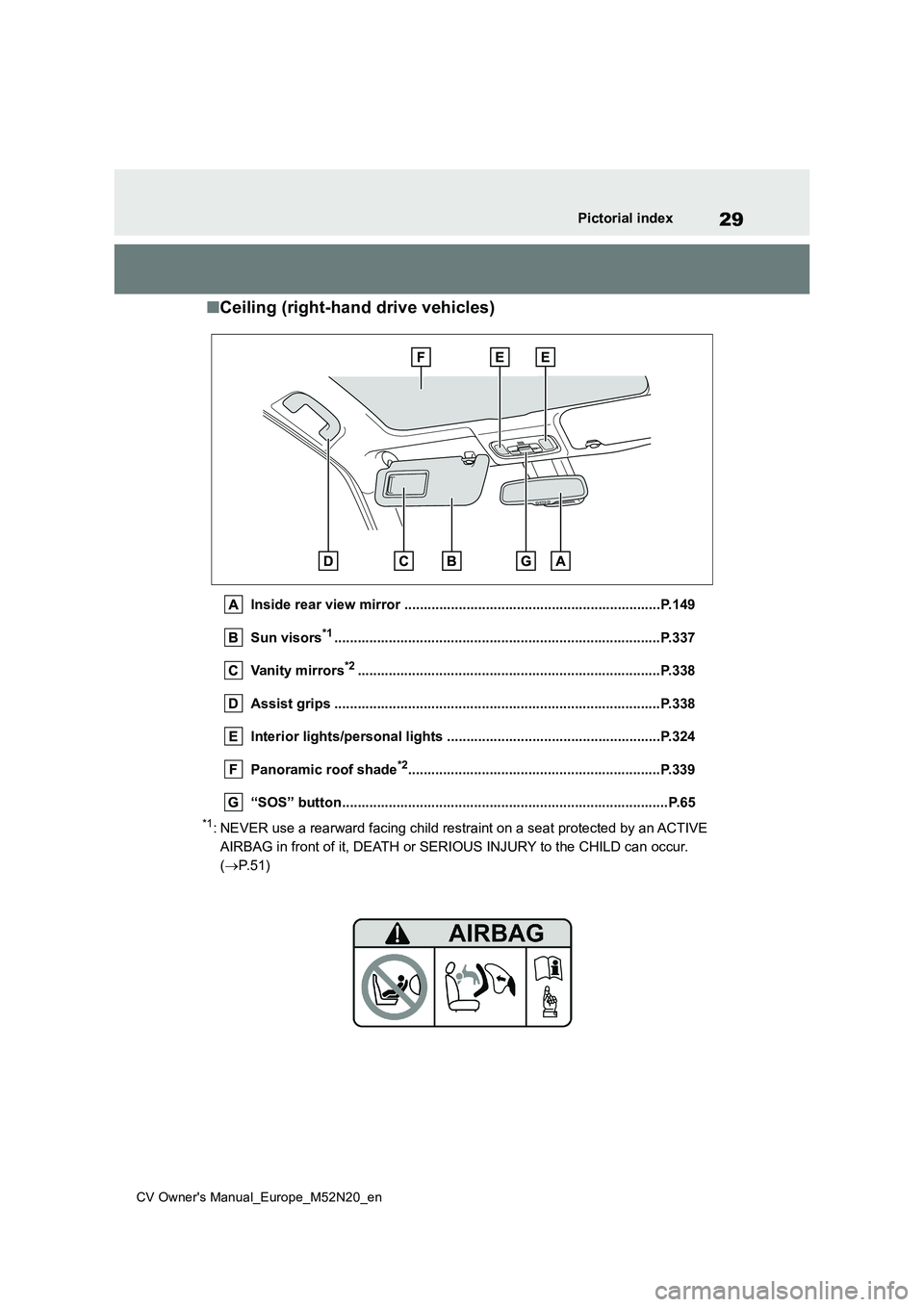
29
CV Owner's Manual_Europe_M52N20_en
Pictorial index
■Ceiling (right-hand drive vehicles)
Inside rear view mirror ..................................................................P.149
Sun visors*1............................................................... .....................P.337
Vanity mirrors*2............................................................... ...............P.338
Assist grips ................................................... .................................P.338
Interior lights/personal lights ................................ .......................P.324
Panoramic roof shade*2............................................................... ..P.339
“SOS” button................................................... .................................P.65
*1: NEVER use a rearward facing child restraint on a seat protected by an ACTIVE
AIRBAG in front of it, DEATH or SERIOUS INJURY to the CHILD can occur.
( P.51)
Page 35 of 618
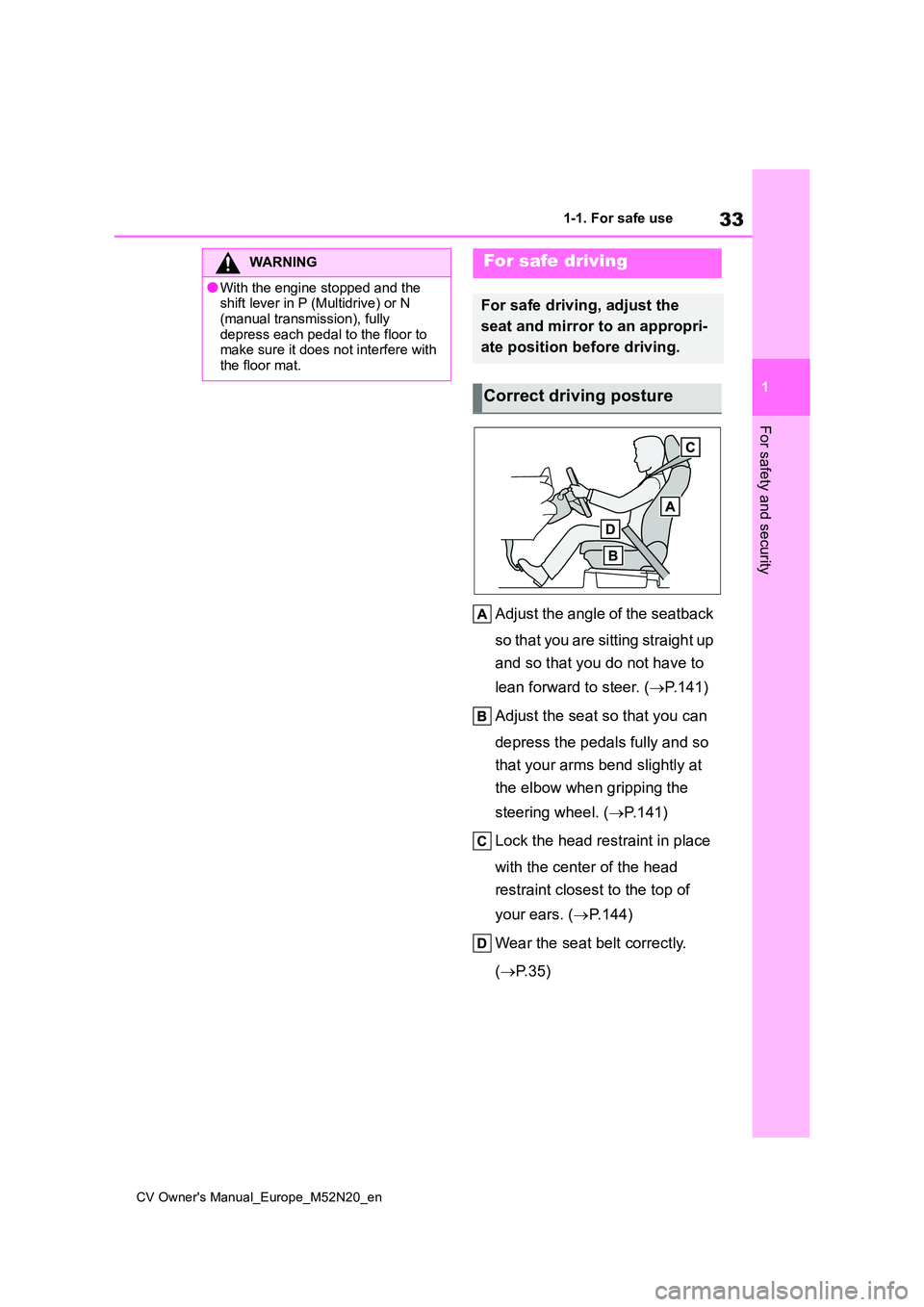
33
1
CV Owner's Manual_Europe_M52N20_en
1-1. For safe use
For safety and security
Adjust the angle of the seatback
so that you are sitting straight up
and so that you do not have to
lean forward to steer. ( P.141)
Adjust the seat so that you can
depress the pedals fully and so
that your arms bend slightly at
the elbow when gripping the
steering wheel. ( P.141)
Lock the head restraint in place
with the center of the head
restraint closest to the top of
your ears. ( P. 1 4 4 )
Wear the seat belt correctly.
( P. 3 5 )
WARNING
●With the engine stopped and the shift lever in P (Multidrive) or N
(manual transmission), fully depress each pedal to the floor to make sure it does not interfere with
the floor mat.
For safe driving
For safe driving, adjust the
seat and mirror to an appropri-
ate position before driving.
Correct driving posture
Page 39 of 618
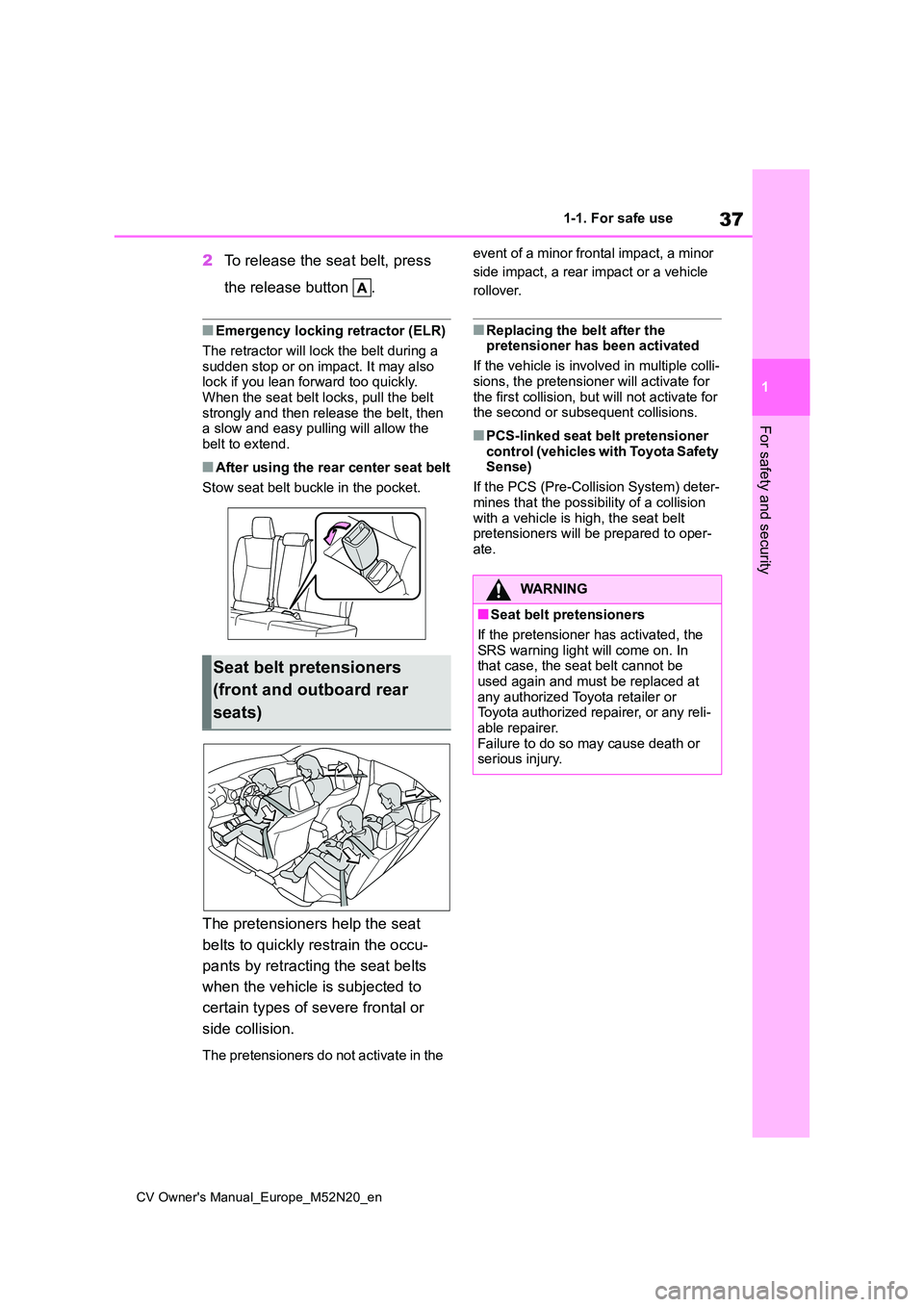
37
1
CV Owner's Manual_Europe_M52N20_en
1-1. For safe use
For safety and security
2To release the seat belt, press
the release button .
■Emergency locking retractor (ELR)
The retractor will lock the belt during a sudden stop or on impact. It may also lock if you lean forward too quickly.
When the seat belt locks, pull the belt strongly and then release the belt, then a slow and easy pulling will allow the
belt to extend.
■After using the rear center seat belt
Stow seat belt buckle in the pocket.
The pretensioners help the seat
belts to quickly restrain the occu-
pants by retracting the seat belts
when the vehicle is subjected to
certain types of severe frontal or
side collision.
The pretensioners do not activate in the
event of a minor frontal impact, a minor
side impact, a rear impact or a vehicle
rollover.
■Replacing the belt after the pretensioner has been activated
If the vehicle is involved in multiple colli-
sions, the pretensioner will activate for the first collision, but will not activate for the second or subsequent collisions.
■PCS-linked seat belt pretensioner
control (vehicles with Toyota Safety Sense)
If the PCS (Pre-Collision System) deter-
mines that the possibility of a collision with a vehicle is high, the seat belt pretensioners will be prepared to oper-
ate.
Seat belt pretensioners
(front and outboard rear
seats)
WARNING
■Seat belt pretensioners
If the pretensioner has activated, the SRS warning light will come on. In that case, the seat belt cannot be
used again and must be replaced at any authorized Toyota retailer or Toyota authorized repairer, or any reli-
able repairer. Failure to do so may cause death or serious injury.
Page 41 of 618
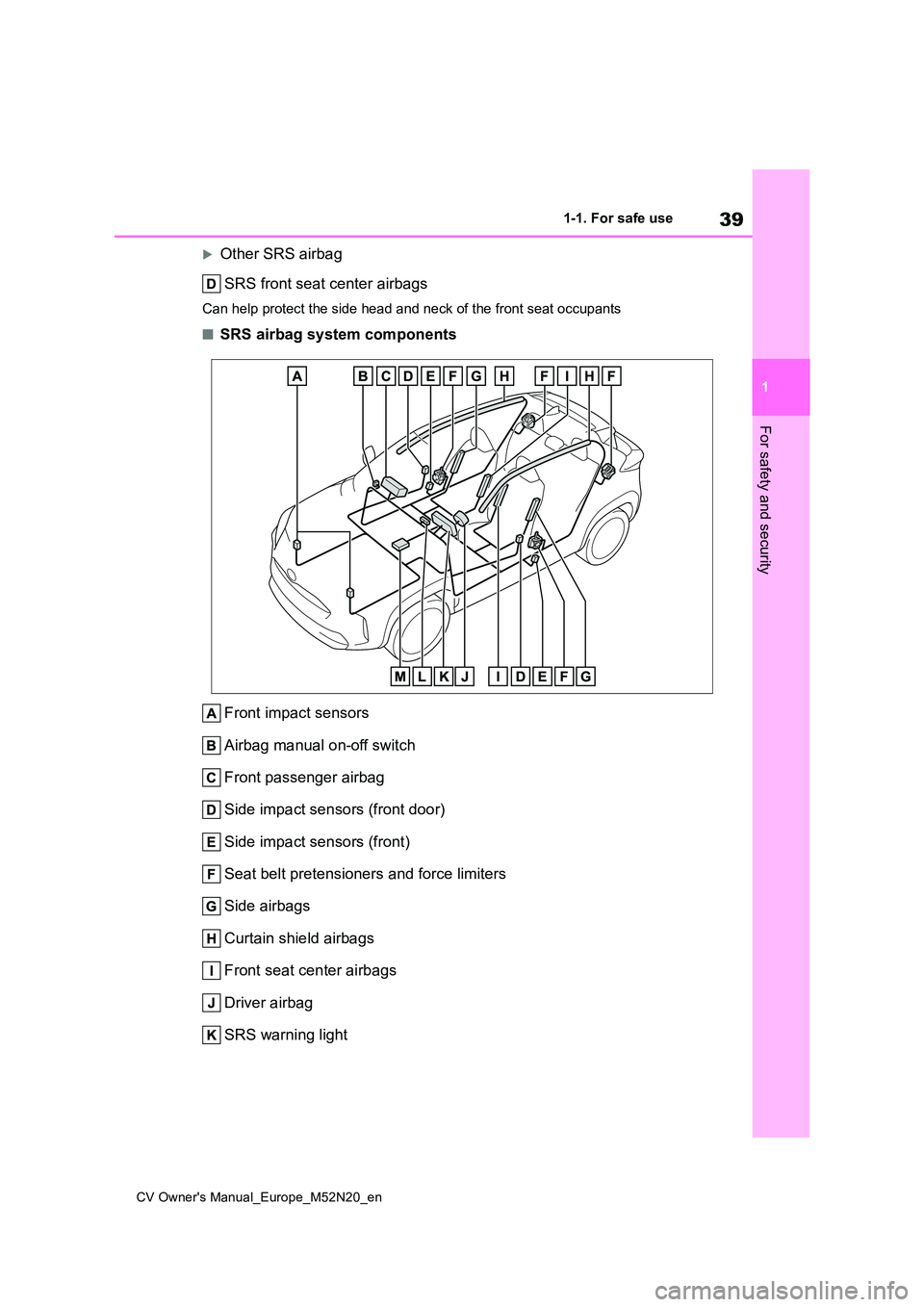
39
1
CV Owner's Manual_Europe_M52N20_en
1-1. For safe use
For safety and security
Other SRS airbag
SRS front seat center airbags
Can help protect the side head and neck of the front seat occup ants
■SRS airbag system components
Front impact sensors
Airbag manual on-off switch
Front passenger airbag
Side impact sensors (front door)
Side impact sensors (front)
Seat belt pretensioners and force limiters
Side airbags
Curtain shield airbags
Front seat center airbags
Driver airbag
SRS warning light
Page 42 of 618
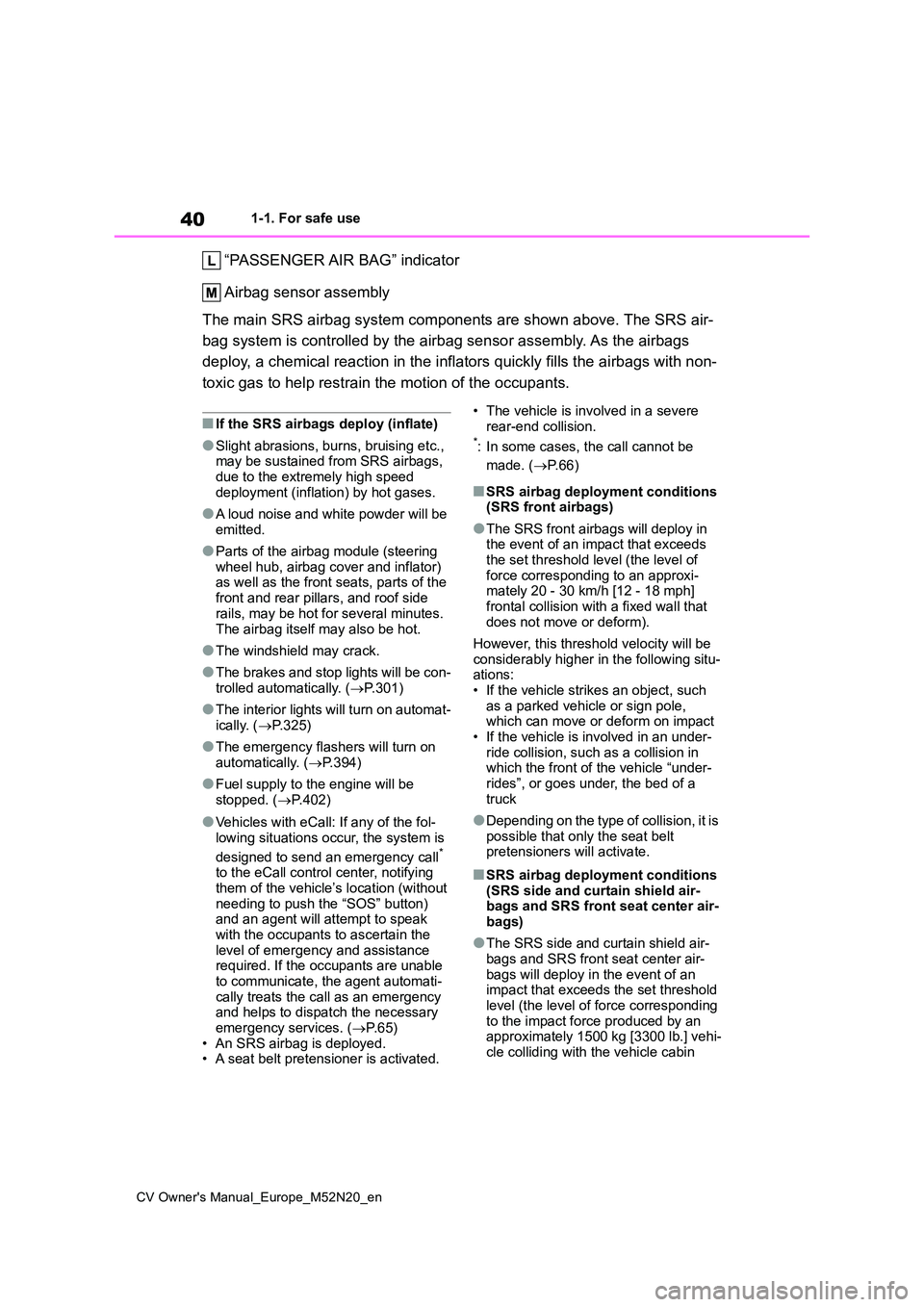
40
CV Owner's Manual_Europe_M52N20_en
1-1. For safe use
“PASSENGER AIR BAG” indicator
Airbag sensor assembly
The main SRS airbag system components are shown above. The SRS air-
bag system is controlled by the airbag sensor assembly. As the airbags
deploy, a chemical reaction in the inflators quickly fills the airbags with non-
toxic gas to help restrain the motion of the occupants.
■If the SRS airbags deploy (inflate)
●Slight abrasions, burns, bruising etc., may be sustained from SRS airbags,
due to the extremely high speed deployment (inflation) by hot gases.
●A loud noise and white powder will be emitted.
●Parts of the airbag module (steering wheel hub, airbag cover and inflator) as well as the front seats, parts of the
front and rear pillars, and roof side rails, may be hot for several minutes.
The airbag itself may also be hot.
●The windshield may crack.
●The brakes and stop lights will be con- trolled automatically. ( P.301)
●The interior lights will turn on automat- ically. ( P.325)
●The emergency flashers will turn on automatically. ( P.394)
●Fuel supply to the engine will be stopped. ( P.402)
●Vehicles with eCall: If any of the fol-
lowing situations occur, the system is
designed to send an emergency call* to the eCall control center, notifying them of the vehicle’s location (without
needing to push the “SOS” button) and an agent will attempt to speak with the occupants to ascertain the
level of emergency and assistance required. If the occupants are unable to communicate, the agent automati-
cally treats the call as an emergency and helps to dispatch the necessary emergency services. ( P.65)
• An SRS airbag is deployed. • A seat belt pretensioner is activated.
• The vehicle is involved in a severe rear-end collision.*: In some cases, the call cannot be
made. ( P. 6 6 )
■SRS airbag deployment conditions (SRS front airbags)
●The SRS front airbags will deploy in the event of an impact that exceeds
the set threshold level (the level of force corresponding to an approxi-mately 20 - 30 km/h [12 - 18 mph]
frontal collision with a fixed wall that does not move or deform).
However, this threshold velocity will be considerably higher in the following situ-ations:
• If the vehicle strikes an object, such as a parked vehicle or sign pole, which can move or deform on impact
• If the vehicle is involved in an under- ride collision, such as a collision in which the front of the vehicle “under-
rides”, or goes under, the bed of a truck
●Depending on the type of collision, it is possible that only the seat belt pretensioners will activate.
■SRS airbag deployment conditions
(SRS side and curtain shield air- bags and SRS front seat center air-bags)
●The SRS side and curtain shield air-bags and SRS front seat center air-
bags will deploy in the event of an impact that exceeds the set threshold level (the level of force corresponding
to the impact force produced by an approximately 1500 kg [3300 lb.] vehi-cle colliding with the vehicle cabin
Page 45 of 618
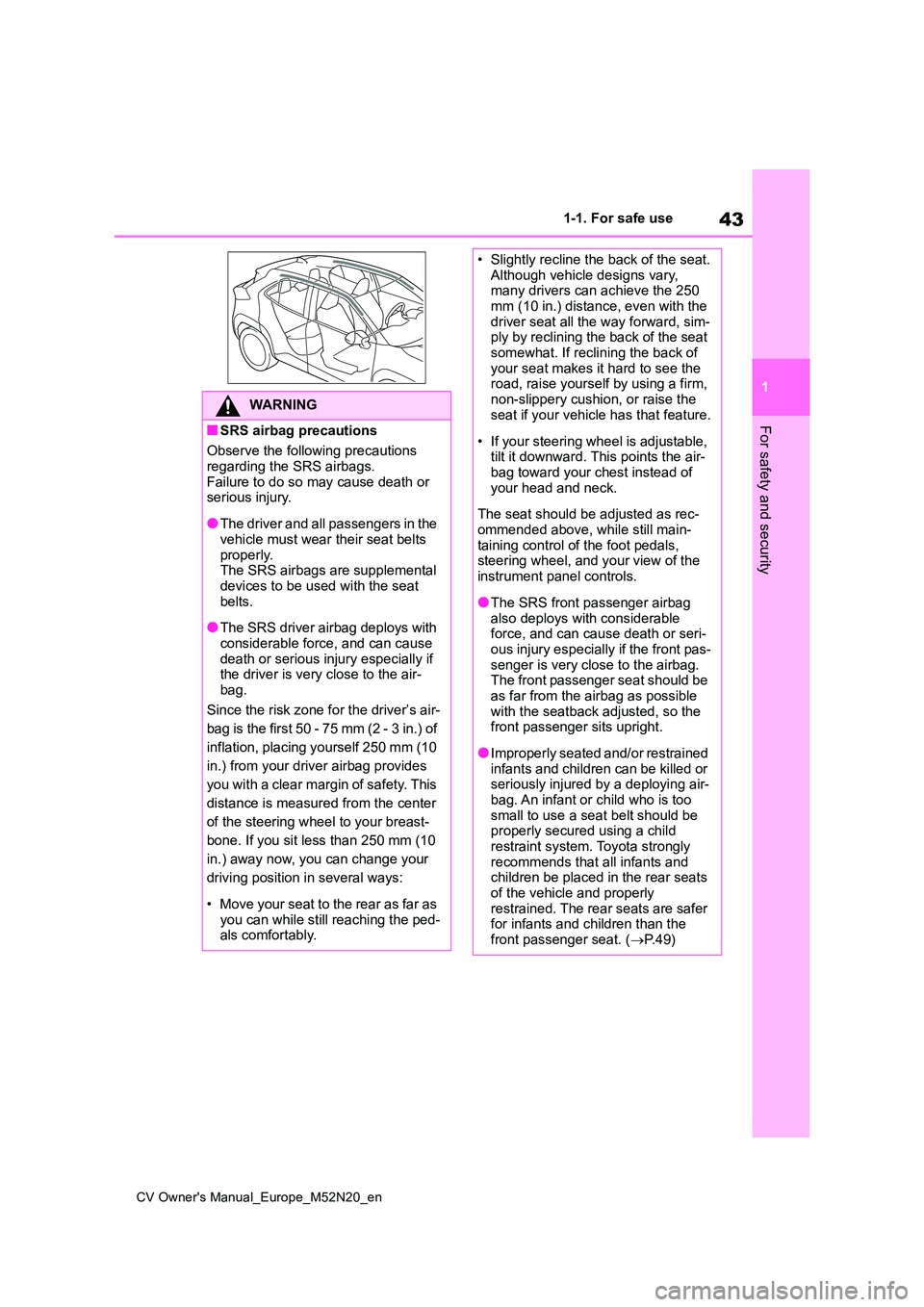
43
1
CV Owner's Manual_Europe_M52N20_en
1-1. For safe use
For safety and security
WARNING
■SRS airbag precautions
Observe the following precautions
regarding the SRS airbags. Failure to do so may cause death or serious injury.
●The driver and all passengers in the vehicle must wear their seat belts
properly. The SRS airbags are supplemental devices to be used with the seat
belts.
●The SRS driver airbag deploys with
considerable force, and can cause death or serious injury especially if the driver is very close to the air-
bag.
Since the risk zone for the driver’s air-
bag is the first 50 - 75 mm (2 - 3 in.) of
inflation, placing yourself 250 mm (10
in.) from your driver airbag provides
you with a clear margin of safety. This
distance is measured from the center
of the steering wheel to your breast-
bone. If you sit less than 250 mm (10
in.) away now, you can change your
driving position in several ways:
• Move your seat to the rear as far as you can while still reaching the ped-als comfortably.
• Slightly recline the back of the seat.Although vehicle designs vary, many drivers can achieve the 250
mm (10 in.) distance, even with the driver seat all the way forward, sim-ply by reclining the back of the seat
somewhat. If reclining the back of your seat makes it hard to see the road, raise yourself by using a firm,
non-slippery cushion, or raise the seat if your vehicle has that feature.
• If your steering wheel is adjustable, tilt it downward. This points the air-bag toward your chest instead of
your head and neck.
The seat should be adjusted as rec-
ommended above, while still main- taining control of the foot pedals, steering wheel, and your view of the
instrument panel controls.
●The SRS front passenger airbag
also deploys with considerable force, and can cause death or seri-ous injury especially if the front pas-
senger is very close to the airbag. The front passenger seat should be as far from the airbag as possible
with the seatback adjusted, so the front passenger sits upright.
●Improperly seated and/or restrained infants and children can be killed or seriously injured by a deploying air-
bag. An infant or child who is too small to use a seat belt should be properly secured using a child
restraint system. Toyota strongly recommends that all infants and children be placed in the rear seats
of the vehicle and properly restrained. The rear seats are safer for infants and children than the
front passenger seat. ( P. 4 9 )
Page 48 of 618
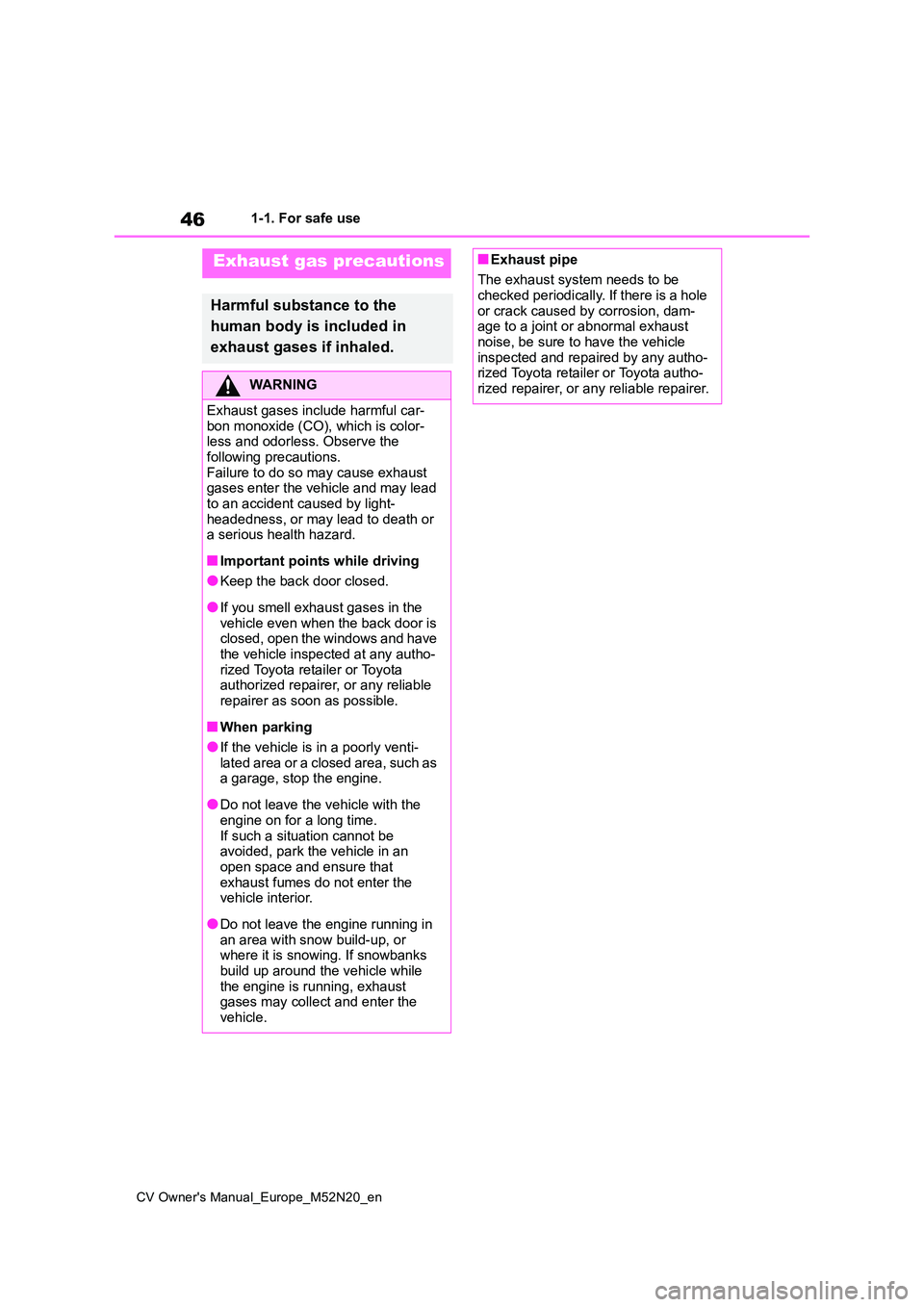
46
CV Owner's Manual_Europe_M52N20_en
1-1. For safe use
Exhaust gas precautions
Harmful substance to the
human body is included in
exhaust gases if inhaled.
WARNING
Exhaust gases include harmful car-
bon monoxide (CO), which is color- less and odorless. Observe the following precautions.
Failure to do so may cause exhaust gases enter the vehicle and may lead to an accident caused by light-
headedness, or may lead to death or a serious health hazard.
■Important points while driving
●Keep the back door closed.
●If you smell exhaust gases in the vehicle even when the back door is closed, open the windows and have
the vehicle inspected at any autho- rized Toyota retailer or Toyota authorized repairer, or any reliable
repairer as soon as possible.
■When parking
●If the vehicle is in a poorly venti- lated area or a closed area, such as a garage, stop the engine.
●Do not leave the vehicle with the engine on for a long time.
If such a situation cannot be avoided, park the vehicle in an open space and ensure that
exhaust fumes do not enter the vehicle interior.
●Do not leave the engine running in an area with snow build-up, or where it is snowing. If snowbanks
build up around the vehicle while the engine is running, exhaust gases may collect and enter the
vehicle.
■Exhaust pipe
The exhaust system needs to be checked periodically. If there is a hole
or crack caused by corrosion, dam- age to a joint or abnormal exhaust noise, be sure to have the vehicle
inspected and repaired by any autho- rized Toyota retailer or Toyota autho-rized repairer, or any reliable repairer.